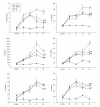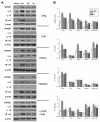Glycyrrhizin protects against porcine endotoxemia through modulation of systemic inflammatory response
- PMID: 23497622
- PMCID: PMC3672474
- DOI: 10.1186/cc12558
Glycyrrhizin protects against porcine endotoxemia through modulation of systemic inflammatory response
Abstract
Introduction: Glycyrrhizin (GL) was recently found to suppress high-mobility group box 1 (HMGB1)-induced injury by binding directly to it. However, the effect of GL on HMGB1 expression in endotoxemia as well as its underlying molecular mechanism remained unclear.
Methods: Twenty-one pigs were divided into four groups: sham group (n=3), control group (n=6), ethyl pyruvate group (n=6) and glycyrrhizin group (n=6). Pigs were anesthetized, mechanically ventilated, monitored and given a continuous intravenous infusion of lipopolysaccharide (LPS). Twelve hours after the start of the LPS infusion, ethyl pyruvate (30 mg/kg/hr) or glycyrrhizin (1 mg/kg/hr) was administered for 12 hours. Systemic and pulmonary hemodynamics, oxygen exchange, and metabolic status were measured. The concentrations of cytokines in serum and the corresponding gene and protein expressions in tissue samples from liver, lungs, kidneys, small intestine and lymph nodes were measured.
Results: GL maintained the stability of systemic hemodynamics and improved pulmonary oxygen exchange and metabolic status. GL also attenuated organ injury and decreased the serum levels of HMGB1 and other pro-inflammatory cytokines by inhibiting their gene and protein expression.
Conclusions: GL improved systemic hemodynamics and protected vital organs against porcine endotoxemia through modulation of the systemic inflammatory response. By reducing the serum level and gene expression of HMGB1 and other pro-inflammatory cytokines, GL may become a potential agent for the treatment of sepsis.
Figures







Similar articles
-
Ethyl pyruvate improves systemic and hepatosplanchnic hemodynamics and prevents lipid peroxidation in a porcine model of resuscitated hyperdynamic endotoxemia.Crit Care Med. 2005 Sep;33(9):2034-42. doi: 10.1097/01.ccm.0000178177.03979.ce. Crit Care Med. 2005. PMID: 16148477
-
Glycyrrhizin protects rat heart against ischemia-reperfusion injury through blockade of HMGB1-dependent phospho-JNK/Bax pathway.Acta Pharmacol Sin. 2012 Dec;33(12):1477-87. doi: 10.1038/aps.2012.112. Epub 2012 Oct 15. Acta Pharmacol Sin. 2012. PMID: 23064724 Free PMC article.
-
Glycyrrhizin improves inflammation and apoptosis via suppressing HMGB1 and PI3K/mTOR pathway in lipopolysaccharide-induced acute liver injury.Eur Rev Med Pharmacol Sci. 2020 Jun;24(12):7122-7130. doi: 10.26355/eurrev_202006_21706. Eur Rev Med Pharmacol Sci. 2020. PMID: 32633407
-
Inhibition effect of glycyrrhizin in lipopolysaccharide-induced high-mobility group box 1 releasing and expression from RAW264.7 cells.Shock. 2015 Apr;43(4):412-21. doi: 10.1097/SHK.0000000000000309. Shock. 2015. PMID: 25526376
-
HMGB1 as a potential therapeutic target.Novartis Found Symp. 2007;280:73-85; discussion 85-91, 160-4. Novartis Found Symp. 2007. PMID: 17380789 Review.
Cited by
-
Glycyrrhizin suppresses the expressions of HMGB1 and relieves the severity of traumatic pancreatitis in rats.PLoS One. 2014 Dec 26;9(12):e115982. doi: 10.1371/journal.pone.0115982. eCollection 2014. PLoS One. 2014. PMID: 25541713 Free PMC article.
-
Glycyrrhizin mitigates radiation-induced acute lung injury by inhibiting the HMGB1/TLR4 signalling pathway.J Cell Mol Med. 2020 Jan;24(1):214-226. doi: 10.1111/jcmm.14703. Epub 2019 Oct 27. J Cell Mol Med. 2020. PMID: 31657123 Free PMC article.
-
Glycyrrhizin ameliorates metabolic syndrome-induced liver damage in experimental rat model.Mol Cell Biochem. 2015 Nov;409(1-2):177-89. doi: 10.1007/s11010-015-2523-y. Epub 2015 Sep 23. Mol Cell Biochem. 2015. PMID: 26400710
-
Glycyrrhizin inhibits porcine epidemic diarrhea virus infection and attenuates the proinflammatory responses by inhibition of high mobility group box-1 protein.Arch Virol. 2017 Jun;162(6):1467-1476. doi: 10.1007/s00705-017-3259-7. Epub 2017 Feb 7. Arch Virol. 2017. PMID: 28175983 Free PMC article.
-
Celastrol mitigates inflammation in sepsis by inhibiting the PKM2-dependent Warburg effect.Mil Med Res. 2022 May 20;9(1):22. doi: 10.1186/s40779-022-00381-4. Mil Med Res. 2022. PMID: 35596191 Free PMC article.
References
-
- Asfar P, Hauser B, Iványi Z, Ehrmann U, Kick J, Albicini M, Vogt J, Wachter U, Brückner UB, Radermacher P, Bracht H. Low-dose terlipressin during long-term hyperdynamic porcine endotoxemia: effects on hepatosplanchnic perfusion, oxygen exchange, and metabolism. Crit Care Med. 2005;33:373–380. doi: 10.1097/01.CCM.0000152253.45901.FB. - DOI - PubMed
Publication types
MeSH terms
Substances
LinkOut - more resources
Full Text Sources
Other Literature Sources

